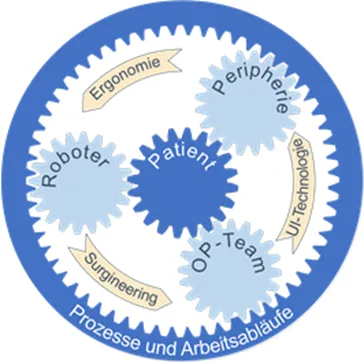ForNero - Seamless and ergonomic integration of robotics into the clinical workflow
Contact Person
Project Contact: Dr. Ulrich Eck, ulrich.eck(at)tum.de
Abstract
The introduction of robotic assistance systems (RAS) into the clinical workflow leads to a considerable increase in technical, social and organizational complexity in the operating theatre and adjacent areas. Even with the latest models, the provision and installation of the systems leads to significant delays, which limit the use of RAS, especially for short procedures. The positioning of the robotic system or the individual modules on the human has a significant influence on the subsequent performance and must take into account the patient's anatomy and the system's working space. In order to effectively utilize the advantages of a RAS, a coordinated interaction between humans and technology is essential. This can only be achieved by integrating the processes of individual surgical planning as closely as possible, taking into account patient-specific parameters and imaging, documentation and integration into the OR environment.
The process-oriented integration of RAS is currently the biggest deficit here, as this does not actually exist. Traditional workflows and processes have not yet been adapted to the use of RAS, or only at the expense of OR staff and process efficiency, and therefore require comprehensive revision and adaptation to the new technology. Particular challenges arise with regard to the positioning and arrangement of the robotic system in the operating room and on the patient, the integration of RAS into the surgical workflow and the individual phases of the intervention (robotic, hybrid, conventional), the efficient display and preparation of relevant information for the OR team, and communication between RAS, the operators, the supporting OR staff and, in some cases, the patient. As studies show, the lack of integration leads to an increased risk of surgical errors and thus to an avoidable risk for patients, as well as to a sometimes considerable increase in operating and process times and thus a significant increase in treatment costs compared to conventional surgical methods. This is not the only reason why robotic applications in medical intervention and imaging, despite their numerous potential advantages, are currently limited to only a few and above all complex cases and are not used at all in some areas. In order to achieve a user-centered, economical and clinically relevant establishment of RAS in clinics to further improve patient care, they must be better integrated.
The research alliance therefore aims to achieve significant improvements in all of these aspects. The outstanding expertise available in the network with regard to the implementation of ergonomic principles (human, machine, system, process) and the clinically centered realization of user-centered simulations, AR applications and UI technologies serve this purpose. In this context, the listed approaches represent key technologies for future robotic surgery and digital medicine. This goal can only be achieved through the close integration of these competencies with users from the clinic (medical team, nursing, technical assistance) and the involvement of competent industrial partners from Bavaria (figure).
As part of the Bavarian High-Tech Agenda, we want to address the aforementioned challenges with a research alliance of industrial and research institutions and further expand Bavaria as a high-tech location by bundling the future-oriented fields of robotics and medical technology. The research alliance presented here joins forces with the overarching goal of progressively digitalizing the operating theatre and using technical innovations to improve patient safety and quality of life, optimize the efficiency of processes in the operating theatre and preoperative area and reduce the workload of clinical staff. As part of the research alliance, we bring together young, up-and-coming start-ups with leading companies in the field of healthcare technologies and provide a platform for translating the research work of Bavarian universities into a rapidly growing, high-tech market. Specifically, the research alliance will develop methods that
- enable digital planning of robot placement in the operating room in order to create the most efficient workspace possible for the OR staff,
- enable improved utilization of the workspace of robotic systems while avoiding system-system interactions (such as collisions),
- allow full integration of robotic systems into existing workflows with expansion of the range of indications through the use of modular approaches,
- enable ergonomic implementation of the optimal placement and use of robots in the operating room based on AR approaches,
- enable a user-centered, flexible design of robot assistance that is more tailored to the needs of the user,
- enable the detection of critical cognitive and physical stresses and strains in the operating room,
- ensure explainability in data-based (often autonomous) processes.
Location
NARVIS Lab and MrI (TUM Hospital, Rechts der Isar)
